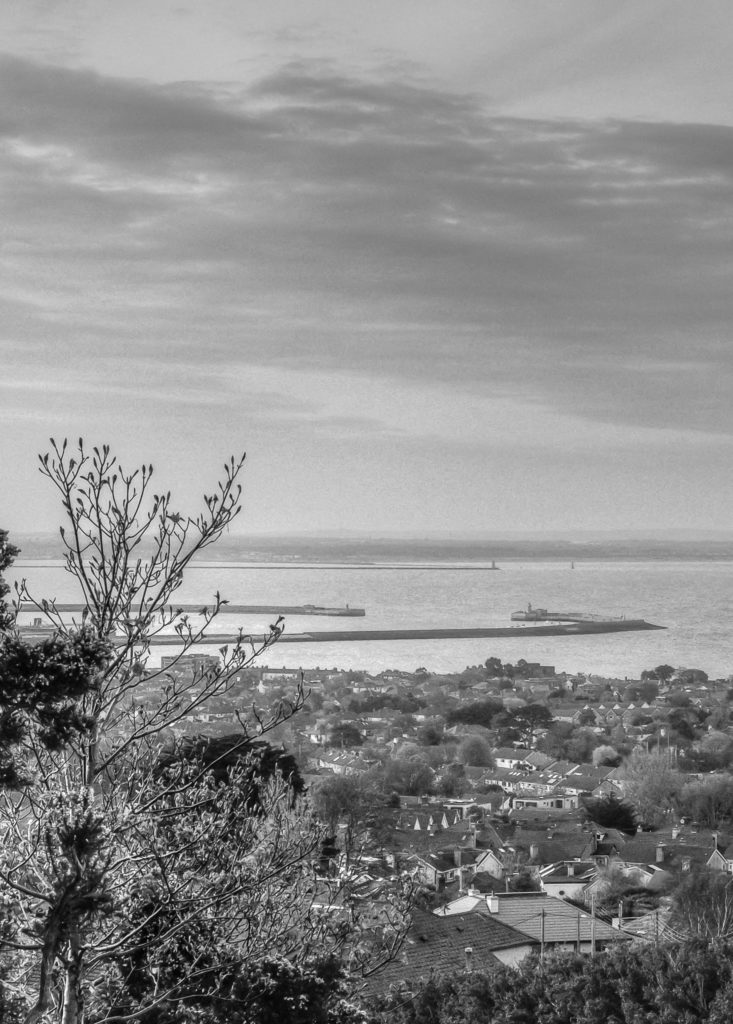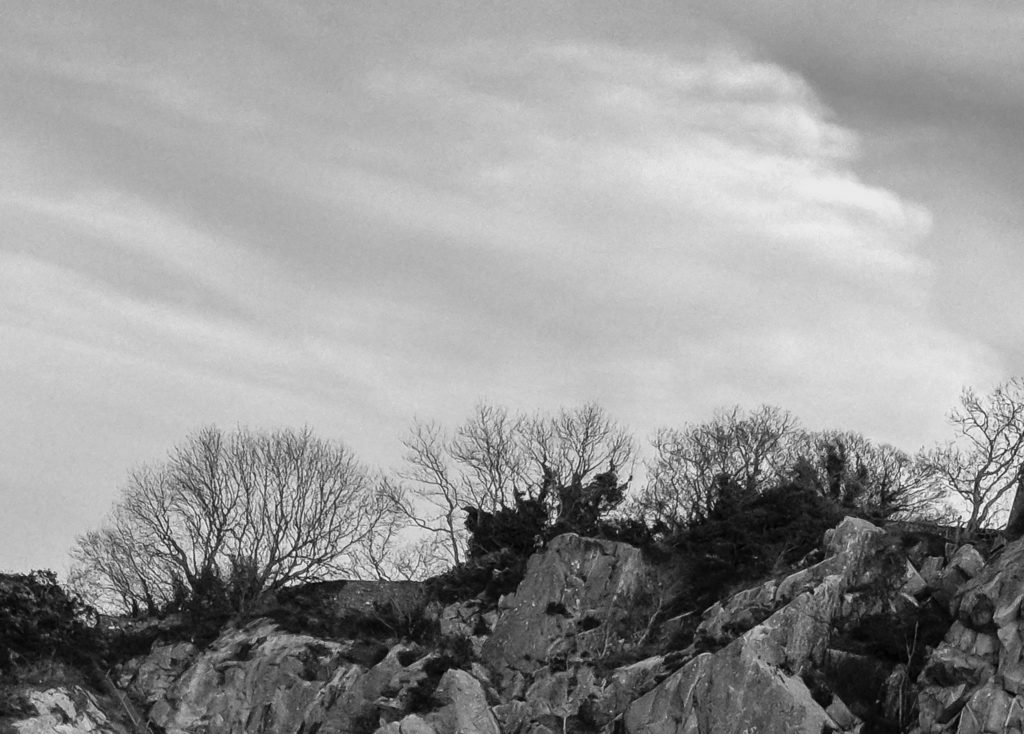My idea for Quarried could be described as a series of exploded views of the one scene, mirroring the way the rock itself was excavated. The harbour in Dun Laoghaire, for example, needed to be visible since the gap in which it would appear was what it was made from. The two harbour piers and that of the South Bull Wall were made from the now absent prominence, a hill that was once higher than anything that survives today. The South Bull was also

Given the timing and sequencing of my chapbooks, springtime was best for this particular project. I wanted there to be trees but before leaf. Even in winter, the leaves that still cling soften the views and diffuse some of the potential drama that permeate black and white photographs. And so mid-April was probably the latest time I could be capturing a scene without leaves.

I knew I’d have to take my chances with human activity and the weather, both of which would be out of my control. The quarry is a very public park, much used by walkers, worriers, cliff-climbers, twitchers and party animals. The weather is what it always is hereabouts in April; unpredictable. And photography does best during the golden hours at dawn ad dusk. Thus were my opportunities constricted to golden daylight. As in so much of photography, serendipity would play a role. I would have to be in the right place at the right time with the right weather and light to catch the one second I desired.
The technical challenge has always been getting a photo that had sufficient resolution from which I could extract printable images of the many views.
There are 17 photos in most of my chapbooks. To print them properly, they must be at least 3000 pixels wide. Nine of those would require a width of 27,000 pixels. If each photo was 2100 pixels tall, and that’s the bare minimum for printing, the main photo would have to be twice that height to yield a second row of nine. That multiplies up to about 113 megapixels.
A quick reality check. I print 15 pages with imagery. Each page is 15.6 X 21.8 cm. To get sharp prints requires 118 dots per cm (300 dpi). Thus each image needs to be made up of at least 15.6 X 21.8 X 118 X 118 dots which is 4,735,000 dots. Call it 5 million printed dots or 5 megapixels. So my primary photograph, the mother image, would need to be a minimum of 5 X 15 megapixels. That’s 75 contiguous megapixels. I’d presume therefore that 100 megapixels would be the working minimum. And that’s in the same magnitude as the previous estimate.
Realistically, I’d need twice that number in order to have reasonable choice in the selection, cropping and framing.
There are 100 and even a 150 megapixel cameras I might have rented. But that would have taken me into the realms of professional photography which is not my business. I’d have to make do with the 25 or 20 megapixel sensors I already own.
As an aside, I also might have used a monochrome camera. They only record record luminosity and waste no pixels recording red, green and blue. In fact, all digital sensors record luminosity but the superposition of Bayer type filters over the sensor enables the pixels to simulate the colour we see. So in effect, my monochrome image would be halved in resolution because I would be converting a simulated colour photograph back to black and white.
To get a width of 27,000 from a sensor that is 4000 pixels wide requires about 7 photographs. And there need to be two rows. So the minimum number of panned exposures was 14. But panoramas require at least 30% overlap in each direction. So already we’re looking at thirty or forty images that would need to be acquired and merged with a computer. It became 53 when I stood in the quarry and realised that there had to be three rows due to the elevation change across the scene.
Megapixels matter but so does the size of the photosites that make up each of those pixels. The pixels on my 2011 Canon are each a dozen times larger by surface area than those on my 2019 iPhone 11. The 18 MP Canon can collect and record almost 20 times more light than the 12 MP phone for the same exposure values. So it was always going to be done with a camera rather than a smart phone.
Shutter speed would be an issue because of the stitching of the photographs into a panorama. Any blur at all would be visible and worse, it would differ frame to frame in the 30% overlap zones. It seemed like I’d need to use my tripod. And I tried it with the Canon but it was too unwieldy on the small outcrop of rock that was my preferred perch.
This was another challenge for which I own the technical solution. My Fuji XT-4 has electronic image stabilisation in both the lens and on the sensor. That pushed me to consider the Fuji in preference to the Canon which was too heavy to manipulate and only has image stabilisation in the lens.
Should I polarise the light? I wondered, tested and decided not. It was removing some scattered light but the price for the clarity was a stop of light or more. I was already at the threshhold of sufficient brightness during the golden hours.
Indeed, I realised that as I panned across the scene, the contrast in the shadows was varying in the time I panned. I already knew I couldn’t do this on a cloudy day because clouds scudding across the sun would change the light, frame to frame. So I decided to take three photographs each time I clicked the shutter. I’d vary the exposures by one third of a stop using the high dynamic range technique. I tested how this worked several times and realised that it was a tricky thing to do but it would really help if I could get it right.
The tripod came back into the project at this point. I could use tripod to reduce jitter and I could use the Fuji phone app as my shutter release, further reducing blur. I practiced and practiced the panning both for stability and speed.
In short, the mother photograph was made from 159 photographs collected within a couple of minutes. Three overlapping rows of 18 scenes each taken with three exposures at 19:29 on the 17th April. Pigeons ruined three but I had enough redundancy to complete the HDR Panorama and create the 25405 X 10740 pixel final image, almost 273 megapixels (1.2 gigabytes on disk).
to be continued …
Quarried: Available now from Bracket Books Ireland at outlets like FabHappy or WalkingCommentary.

Leave a Reply